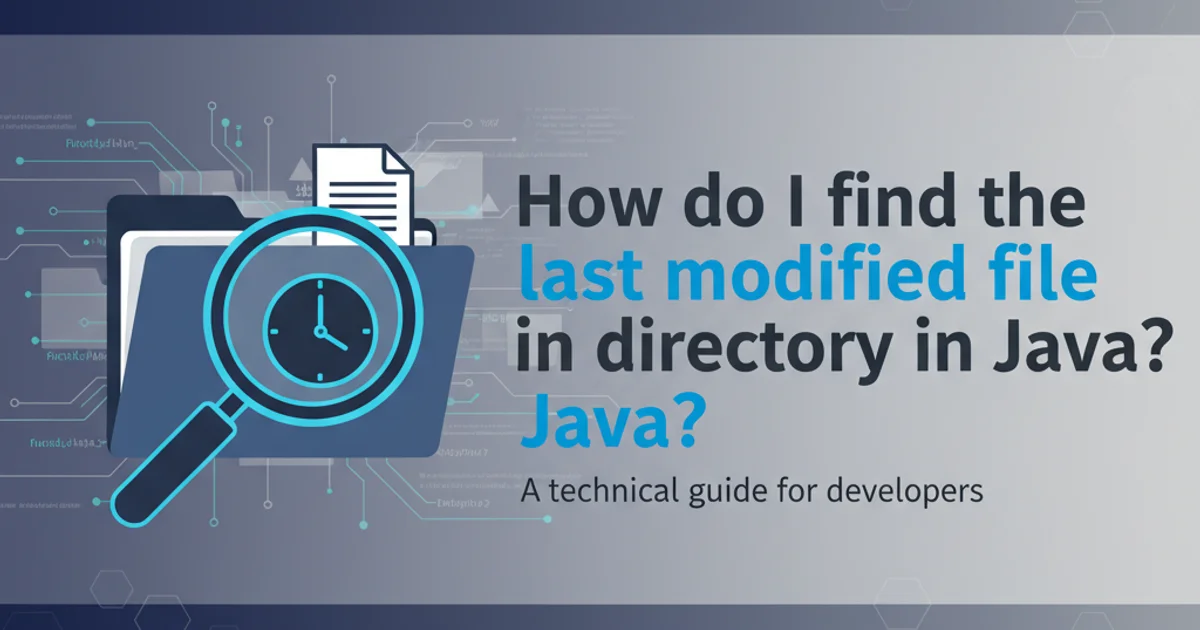How do I find the last modified file in a directory in Java?
Categories:
Finding the Last Modified File in a Java Directory

Learn various Java approaches to efficiently identify the most recently modified file within a specified directory, covering both basic and advanced techniques.
Locating the most recently updated file in a directory is a common task in many Java applications, from log file analysis to content management systems. This article explores several robust methods to achieve this, leveraging Java's java.io.File and java.nio.file APIs. We'll cover traditional approaches and more modern, stream-based solutions, providing practical code examples and performance considerations.
Understanding File Modification Timestamps
Every file in a file system typically stores metadata, including its last modification time. In Java, this information is accessible via the lastModified() method of the File class or Files.getLastModifiedTime() for Path objects. This timestamp is crucial for determining which file is the 'newest'. It's important to note that lastModified() returns a long representing milliseconds since the Unix epoch, while Files.getLastModifiedTime() returns a FileTime object, which offers more precision and flexibility.
flowchart TD
A[Start] --> B{Specify Directory Path}
B --> C{List Files in Directory}
C --> D{Iterate Through Files}
D --> E{Check if File is Regular File}
E -- Yes --> F{Get Last Modified Time}
E -- No --> D
F --> G{Compare with Current 'Latest' File}
G -- Newer --> H[Update 'Latest' File and Time]
G -- Older --> D
H --> D
D --> I{All Files Processed?}
I -- Yes --> J[Return Latest File]
I -- No --> D
J --> K[End]Flowchart illustrating the general logic for finding the last modified file.
Method 1: Using java.io.File (Traditional Approach)
The java.io.File class has been a staple for file system operations in Java for a long time. This method involves listing all files in a directory, iterating through them, and comparing their lastModified() timestamps to find the most recent one. This approach is straightforward and widely understood.
import java.io.File;
import java.util.Optional;
public class LastModifiedFileIO {
public static Optional<File> findLastModifiedFile(String directoryPath) {
File directory = new File(directoryPath);
if (!directory.exists() || !directory.isDirectory()) {
System.err.println("Invalid directory path: " + directoryPath);
return Optional.empty();
}
File[] files = directory.listFiles();
if (files == null || files.length == 0) {
return Optional.empty();
}
File lastModifiedFile = null;
long lastModifiedTime = Long.MIN_VALUE;
for (File file : files) {
if (file.isFile()) { // Ensure it's a file, not a subdirectory
if (file.lastModified() > lastModifiedTime) {
lastModifiedTime = file.lastModified();
lastModifiedFile = file;
}
}
}
return Optional.ofNullable(lastModifiedFile);
}
public static void main(String[] args) {
String path = "."; // Current directory for example
Optional<File> latestFile = findLastModifiedFile(path);
if (latestFile.isPresent()) {
System.out.println("Last modified file: " + latestFile.get().getName());
System.out.println("Last modified time: " + new java.util.Date(latestFile.get().lastModified()));
} else {
System.out.println("No files found or directory is invalid.");
}
}
}
Java code using java.io.File to find the last modified file.
File.listFiles(), remember that it returns null if the directory does not exist or is not a directory, and an empty array if the directory is empty. Always handle these cases to prevent NullPointerException.Method 2: Using java.nio.file (Modern Approach with Streams)
Java's New I/O (NIO.2) API, introduced in Java 7, provides a more robust and flexible way to interact with the file system. The java.nio.file.Files and java.nio.file.Path classes, combined with Java 8 streams, offer a concise and often more performant solution, especially for larger directories. This approach is generally preferred for new development.
import java.io.IOException;
import java.nio.file.Files;
import java.nio.file.Path;
import java.nio.file.Paths;
import java.nio.file.attribute.FileTime;
import java.util.Comparator;
import java.util.Optional;
import java.util.stream.Stream;
public class LastModifiedNIO {
public static Optional<Path> findLastModifiedFile(String directoryPath) {
Path directory = Paths.get(directoryPath);
if (!Files.exists(directory) || !Files.isDirectory(directory)) {
System.err.println("Invalid directory path: " + directoryPath);
return Optional.empty();
}
try (Stream<Path> walk = Files.walk(directory, 1)) { // depth 1 for direct children only
return walk
.filter(Files::isRegularFile) // Only consider regular files
.max(Comparator.comparing(path -> {
try {
return Files.getLastModifiedTime(path);
} catch (IOException e) {
System.err.println("Error getting last modified time for " + path + ": " + e.getMessage());
return FileTime.fromMillis(Long.MIN_VALUE); // Treat as very old if error occurs
}
}));
} catch (IOException e) {
System.err.println("Error walking directory: " + e.getMessage());
return Optional.empty();
}
}
public static void main(String[] args) {
String path = "."; // Current directory for example
Optional<Path> latestFile = findLastModifiedFile(path);
if (latestFile.isPresent()) {
System.out.println("Last modified file: " + latestFile.get().getFileName());
try {
System.out.println("Last modified time: " + Files.getLastModifiedTime(latestFile.get()));
} catch (IOException e) {
System.err.println("Could not get modified time for latest file: " + e.getMessage());
}
} else {
System.out.println("No files found or directory is invalid.");
}
}
}
Java code using java.nio.file and streams to find the last modified file.
Files.walk(), be mindful of the maxDepth parameter. Setting it to 1 (as in the example) ensures you only process direct children of the specified directory. Omitting it or setting it to a higher value will traverse subdirectories, which might not be desired for this specific task and can be resource-intensive for large file systems.Performance Considerations and Best Practices
While both methods achieve the goal, the NIO.2 approach with streams is generally more efficient and cleaner, especially for larger directories or when dealing with complex filtering. Here are some best practices:
- Error Handling: Always include robust error handling for
IOExceptionwhen dealing with file system operations. - Resource Management: Ensure that
Stream<Path>resources are properly closed, typically by using a try-with-resources statement. - Filtering: Explicitly filter for
isRegularFile()to avoid comparing directories, which might have different modification semantics or cause unexpected behavior. - Optional Return Type: Returning an
Optional<File>orOptional<Path>is a good practice to clearly indicate that a file might not be found (e.g., empty directory, invalid path) without returningnull.